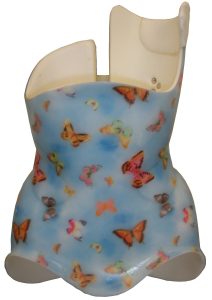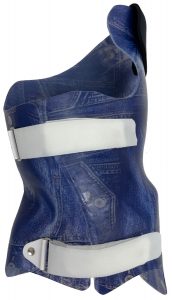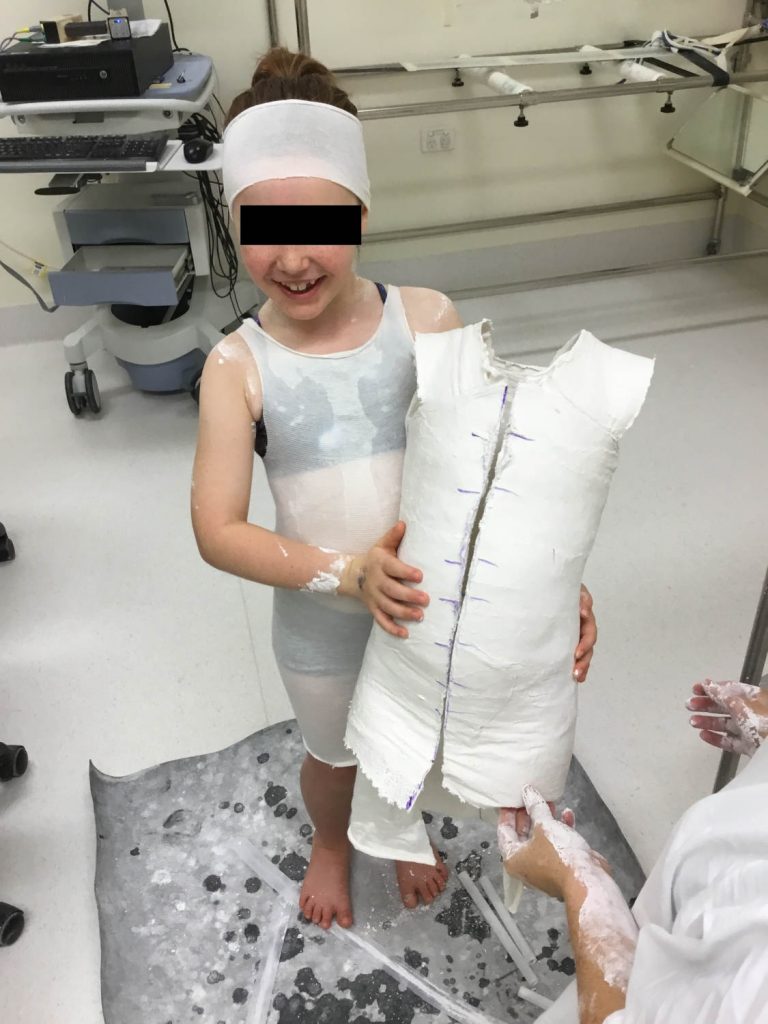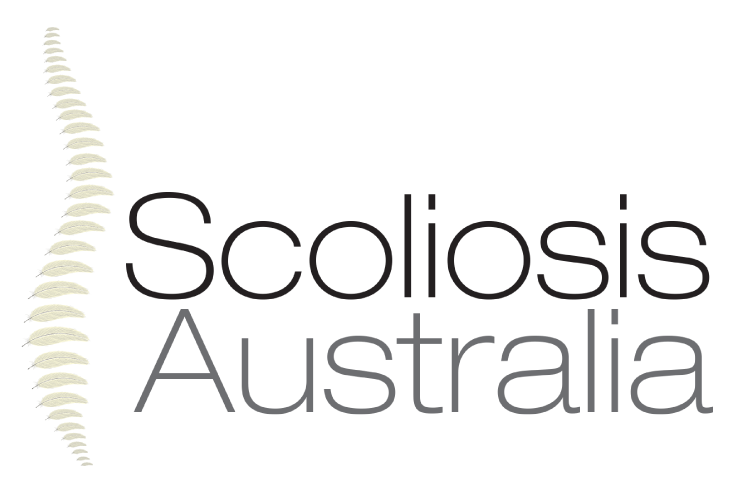A brief history of bracing
Since ancient times, there have been treatments for scoliosis. Hippocrates (5th-4th BCE) gave the deformity its name and designed a traction table to stretch people with curves or spinal injuries. Ambrose Pare (1510-1590) was a French army surgeon who was credited with designing the first brace (a padded iron corset) to try and prevent progressive spinal deformity. In the late 1800s, plaster jackets applied under traction were used. In 1924 two US surgeons, Lovett and Brewster added a turnbuckle. The plaster jacket was applied as top and bottom sections and a hinge placed between them on the convex side of the deformity. The turnbuckle – a threaded rod and wingnut was connected to the concave side. The nut was turned and over time this gradually straightened the spine by opening up that side of the cast. To hold the correction in place a surgical fusion of the spine was performed and the person spent another 8 to 10 months in a new plaster jacket.
In 1946, Walter Blount developed a removable brace, called the Milwaukee. This had a pelvic base made of leather, connected to rods that extended to a chin piece. It was initially designed for people whose back muscles had been paralysed by polio, but was used later to treat scoliosis and kyphosis (forward bend of the spine). It is still used today, although the materials and designs have changed.
The Milwaukee brace was not comfortable and very obvious. It was not an easy thing to wear. Beginning in the 1960s, lower profile braces, such as the Boston brace, were developed to reduce some of these problems. There are now many different styles of brace utilised throughout the world.
What is a brace?
The term ‘brace’ is a common term for an orthosis. An orthosis is the technical name for an externally applied assistive device that is designed to support or protect a body segment.
An orthosis used in the treatment of scoliosis is called a TLSO. This stands for Thoraco-Lumbar-Sacral Orthosis and simply describes the segments of the spine that it acts on.
Who needs to wear a brace?
There are fairly clear guidelines as to when a brace is needed (and when its not). Here they are, as recommended by the Scoliosis Research Society:
1. A curve between 20 and 40 degrees that is not too high or low on the spine,
2. In someone with at least 18 months of growth remaining,
3. And being prepared to wear the brace for 16 to 20 hours a day until they stop growing.
In these circumstances, there is at least a 70% chance that the curve won’t progress into the range where surgery would be needed. A recent study has proven the effectiveness of bracing.
For bracing to be effective, a big commitment is needed from the teenager and the family. It takes time to get used to it and include it in their daily routine. In summer it is hot to wear. A t-shirt or singlet underneath helps. For the 4 to 8 hours out of the brace, some of that time should be used to exercise, so that the back and trunk muscles don’t get weak.
It’s also important to note that there is no point bracing a curve that does not need it. Curves under 20 degrees need to be carefully watched, to ensure that they’re not progressing, but they don’t need a brace. Similarly, people with no or not much growth remaining do not need to wear one.
So, if you have to wear a brace, firstly know that it has a good chance of stopping the curve. Secondly, almost everyone can manage to wear it for the required time. Thirdly, it’s not forever. Lastly, at least you don’t have to go through what people with scoliosis did more than 40 years ago.
How does a brace work?
A brace works by applying external forces on the spine to hold the spine in a corrected position during remaining growth.
While the spine will be straighter while wearing the brace, it cannot make the spine permanently straight. When the brace is removed, the spine will return back to it’s natural position. A brace is only intended to prevent a scoliotic spine from becoming any more bent or even if it increases, the curve doesn’t get to the size where surgery would be needed.

Types of scoliosis braces
There are many styles of TLSOs used in the treatment of scoliosis. The two most common styles in Australia are the Boston style and Cheneau style.
Boston Style
Traditional style of scoliosis bracing in Australia.
• Plastic shell
• Foam liner
• Rear opening
• May be custom-made or prefabricated

Cheneau Style
Becoming the predominant style in Australia.
• Plastic shell
• No liner
• Front opening
• Has load areas and ‘void’ areas.
• May have specific load pads

How do I get a brace?
Your orthopaedic surgeon will refer you to an Orthotist.
What is an Orthotist?
An orthotist is a tertiary qualified Allied Health Professional who assesses and treats the physical and functional limitations of people resulting from illnesses and disabilities. Orthotists are trained to prescribe, design, fit and monitor orthoses.
How to find an Orthotist
Australian Orthotic Prosthetic Association (AOPA) Find a Practitioner:
What happens when I see an Orthotist?
Initial Appointment
Your orthotist will ask you some questions about your back, look at your x-rays and have a look at your spine. They will then take some measurements and either a 3D scan or plaster cast mould of your back from your shoulders to your hips.
They will need to see your whole spine, so for teenage girls it is preferable that you wear a crop top/bikini top and leggings/bike shorts to this appointment, and wear your hair tied up. If you are having a plaster cast taken it is a good idea to bring a change of underwear for when the casting is complete.
The orthotist will then manufacture your brace from these measures and scan/cast.

POP cast wrap 
POP cast cut off and finished 
Scanning 
Laser scan – red dots (computer)
Fitting Appointment
Your orthotist will fit your new brace to you. It may require some adjustment or trimming to ensure that it fits you properly.
It is important that you bring a good-fitting singlet to wear underneath your brace. It is also a good idea to wear leggings/bike shorts or other pants with a thin waistband so that the brace can fit over the top.
Once the brace is fitting well, your orthotist will talk to you about how to use the brace correctly, how it will fit into your routine and how to take care of it.
State of Orthotic Services in Australia
Currently in Australia, there is no requirement for the supplier of an orthotic device to be registered with any government or regulatory body. This means that anybody who wishes to prescribe, manufacture and/or fit a brace for scoliosis can do so without regulation.
Various brace suppliers you may encounter include orthotists, physiotherapists, occupational therapists, chiropractors and osteopaths. Orthotists are the only healthcare practitioners that are specifically trained and qualified to manufacture and fit a brace for scoliosis.
In the public hospital system, the only healthcare professional that is permitted to manufacture and fit scoliosis braces are orthotists. They have completed their degree in Prosthetics and Orthotics as a prior condition for employment. In the private system there is no requirement. Ask your practitioner what qualification they hold. You can also check to see if they are an accredited orthotist by looking on the Australian Orthotic and Prosthetic Association (AOPA) website.
When deciding on where to go for a brace it is important to do your research. Look at the qualifications of the supplier and satisfy yourself that they hold an appropriate qualification.
Links:
AOPA Fact Sheet:
https://www.aopa.org.au/publications/spinal-orthoses
SRS BrAIST Study:
https://www.srs.org/professionals/online-education-and-resources/braist-presentation
* * *
